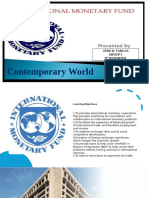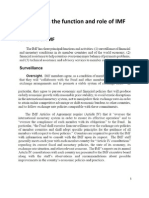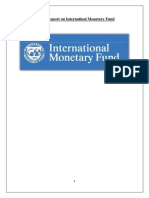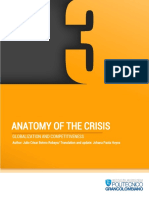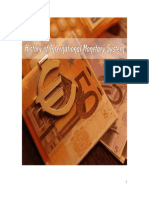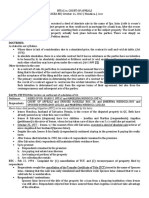IMF London Digital L
IMF London Digital L
Uploaded by
rohitcnlu601Copyright:
Available Formats
IMF London Digital L
IMF London Digital L
Uploaded by
rohitcnlu601Copyright
Available Formats
Share this document
Did you find this document useful?
Is this content inappropriate?
Copyright:
Available Formats
IMF London Digital L
IMF London Digital L
Uploaded by
rohitcnlu601Copyright:
Available Formats
Order Code RS22976 Updated October 30, 2008
The Global Financial Crisis: The Role of the International Monetary Fund (IMF)
Martin A. Weiss Specialist in International Trade and Finance Foreign Affairs, Defense, and Trade Division
Summary
This report discusses two potential roles the International Monetary Fund (IMF) may have in helping to resolve the current global financial crisis: (1) immediate crisis control through balance of payments lending to emerging market and less-developed countries and (2) increased surveillance of the global economy through better coordination with the international financial regulatory agencies. This report will be updated as events warrant.
The current global financial crisis, which began with the downturn of the U.S. subprime housing market in 2007, is testing the ability of the International Monetary Fund (IMF), in its role as the central international institution for oversight of the global monetary system. Though the IMF is unlikely to lend to the developed countries most affected by the crisis and must compete with other international financial institutions1 as a source of ideas and global macroeconomic policy coordination, the spillover effects of the crisis on emerging and less-developed economies gives the IMF an opportunity to reassert its role in the international economy on two key dimensions of the global financial crisis: (1) immediate crisis management and (2) long-term systemic reform of the international financial system. The role of the IMF has changed significantly since its founding in July 1944. Late in World War II, delegates from 44 nations gathered in Bretton Woods, New Hampshire to discuss the postwar recovery of Europe and create a set of international institutions to resolve many of the economic issues such as protectionist trade policies and unstable exchange rates that had ravaged the international economy between the two world wars. As the global financial system has evolved over the decades, so has the IMF. From 1946 to 1973, the main purpose of the IMF was to manage the fixed system of international exchange rates agreed on at Bretton Woods. The U.S. dollar was fixed to gold at $35 per ounce and all other member countries currencies were fixed to the dollar
1
Such as the Bank for International Settlements, Financial Stability Forum (FSF), and the Organization for Economic Cooperation and Development (OECD).
CRS-2 at different rates. The IMF monitored the macroeconomic and exchange rate policies of member countries and helped countries overcome balance of payments crises with shortterm loans that helped bring currencies back in line with their determined value. This system came to an abrupt end in 1973 when the United States floated its currency and subsequently introduced the modern system of floating exchange rates. Over the past three decades, floating exchange rates and financial globalization have contributed to, in addition to substantial wealth and high levels of growth for many countries, an international economy marred by exchange rate volatility and semi-frequent financial crises. The IMF adapted to the end of the fixed-exchange rate system by becoming the lender of last resort for countries afflicted by such crises. Current IMF operations and responsibilities can be grouped into three areas: surveillance, lending, and technical assistance. Surveillance involves monitoring economic and financial developments and providing policy advice to member countries. Lending entails the provision of financial resources under specified conditions to assist a country experiencing balance of payments difficulties. Technical assistance includes help on designing or improving the quality and effectiveness of domestic policy-making.
Whither the IMF?
The current financial crisis represents a major challenge for the IMF since the institution is not in financial position to be able to lend to the United States or other Western countries affected by the crisis (with the possible exception of Iceland). The IMFs total financial resources as of August 2008 were $352 billion, of which $257 billion were usable resources.2 The most the IMF ever lent in any one year period (the four quarters through September 1998 at the height of the Asian financial crisis) was $30 billion. The most lent during any two-year period was $40 billion between June 20012003 during the financial crises in Argentina, Brazil, Uruguay, and Turkey.3 The IMF is wholly unequipped to provide by itself the necessary liquidity to the United States and affected industrialized countries. In addition, the United States and other Western countries, along with some Middle Eastern oil states, are the primary contributors to IMF resources, and it is unlikely that these countries would seek IMF assistance. The last time that developed countries borrowed from the IMF was between1976 and1978, when the United Kingdom, Italy, and Spain borrowed from the IMF to deal with the aftershocks of the 1973 increase in oil prices.4 Since the financial crises of a decade ago, many emerging market economies, largely in response to their criticism of the policy conditions that the IMF required of countries receiving IMF loans, have built up extensive foreign reserve positions in order to avoid
IMF resources that are considered non-usable to finance IMF operations are (1) its gold holdings, (2) the currencies of members that are using IMF resources and are therefore, by definition, in a weak balance of payments or reserve position, (3) the currencies of other members with relatively weak external positions, and (4) other non-liquid IMF assets. Brad Setser, Extraordinary Times, Council on Foreign Relations, September 29, 2008. It is worth noting that the final rescue packages during the Asian crisis totaled many times $30 billion once bilateral assistance was included. Oxford Analytica, IMF reaffirms role in global economy. October 15, 2008.
CRS-3 having to return to the IMF should such a crisis occur again.5 From a level of around $1.2 trillion in 1995, global foreign exchange reserves now exceed $7 trillion. The IMF tabulates that by the second quarter of 2008, developing countries foreign reserves were $5.47 trillion compared to $1.43 trillion in the industrialized countries.6 This reserve accumulation was driven by increasing commodity prices (such as oil and minerals) and large current account surpluses combined with high savings rates in emerging Asian countries.7 Emerging market foreign reserve accumulation fueled by rising commodity prices and large emerging market trade surpluses, and net foreign direct investment flows has led to a decrease in demand for IMF lending and a weakening in the IMFs budget position. IMF lending peaked in 2003 with IMF credit outstanding totaling $110.29 billion. By September 30, 2008, outstanding IMF loans had decreased by $92.6 billion to $17.72 billion.8 Since the IMF earns income on the interest paid on its loans, the decrease in demand for IMFs lending led to a budget shortfall in 2007. The IMF is in the process of seeking authorization from national legislatures to sell a portion of gold that the IMF holds in reserve to create an investment fund whose profits can be used to finance IMF operations. Congress is expected to face a vote in FY2009 on whether or not to authorize this proposal. The rise of emerging market countries over the past decade, has created new challenges for the IMF. Many emerging market economies argue that their current stake in the IMF does not represent their role in the world economy. Several countries, particularly in East Asia and South America, believe that their new economic weight and status should afford them a larger quota and a greater voice at the institution. In addition, many poor countries believe that the IMFs quota system is prejudiced against them, giving them little voice even though they are the majority of the IMFs borrowers. In response to these concerns, the IMF embarked in 2006 on a reform process to increase the quota and voice of its emerging market country members.9 While the IMF has struggled to define its role in the global economy, the global financial crisis has created an opportunity for the IMF to reinvigorate itself and possibly play a constructive role in resolving, or at the least mitigating, the effects of the global downturn, on two fronts: (1) through immediate crisis management, primarily balance of payments support to emerging-market and less-developed countries, and (2) contributing to long-term systemic reform of the international financial system.
Many analysts believe that the tight monetary and fiscal policies that the IMF required of countries accepting IMF loans accentuated the immediate economic impact of the crisis while having marginal impact on the countries long-term structural reform.
IMF Currency Composition of Official Foreign Exchange Reserves (COFER) available at [http://www.imf.org/external/np/sta/cofer/eng/index.htm]. Georges Pineau and Ettore Dorruci, The Accumulation of Foreign Reserves, European Central Bank, March 2006.
Total IMF Credit Outstanding for all members from 1984 - 2008, available at [http://www.imf.org/external/np/fin/tad/extcred1.aspx].
For background, see CRS Report RL33626, International Monetary Fund: Reforming Country Representation, by Martin A. Weiss.
CRS-4 Immediate Crisis Management. IMF rules stipulate that countries are allowed to borrow up to three times their quota over a three-year period, although this requirement has been breached on several occasions where the IMF has lent at much higher multiples of quota.10 While many emerging market countries, such as Brazil, India, Indonesia, and Mexico, have stronger macroeconomic fundamentals than they did a decade ago, a sustained decrease in U.S. imports resulting from an economic slowdown could have recessionary effects overseas. Emerging markets with less robust financial structures have been more dramatically affected, especially those dependent on exports to the United States. Increased emerging market default risk can be seen in the dramatic rise of credit default swap (CDS) prices for emerging market sovereign bonds. Financial markets are currently pricing the risk that Pakistan, Argentina, Ukraine, and Iceland will default on their sovereign debt at above 80%.11 On October 24, the IMF announced an initial agreement on a $2.1 billion two-year loan with Iceland. On October 26, the IMF announced a $16.5 billion agreement with Ukraine. On October 27, the IMF announced a $15.7 billion loan to Hungary.12 Other countries in talks with the IMF are Belarus and Pakistan. Other potential candidates for IMF loans are Serbia, Kazakhstan, Pakistan, Lithuania, Latvia, and Estonia.13 IMF Managing Director Dominique Strauss-Kahn has stressed that the IMF is able and poised to assist with crisis loans. At the IMF annual meetings in October 2008, Managing Director Strauss-Kahn announced that the IMF had activated its Emergency Financing Mechanism (EFM) to speed the normal process for loans to crisis-afflicted countries.14 The emergency mechanism enables rapid approval (usually within 48-72 hours) of IMF lending once an agreement has been reached between the IMF and the national government. As noted before, while normal IMF rules are that countries can only borrow three times the size of their respective quotas over three years, the Fund has shown the willingness in the past to lend higher amounts should the crisis require extraordinary amounts of assistance. A second instrument that the IMF could use to provide financial assistance is its Exogenous Shock Facility (ESF). The ESF provides policy support and financial assistance to low-income countries facing exogenous shocks, events that are completely out of the national governments control. These could include commodity price changes (including oil and food), natural disasters, and conflicts and crises in neighboring countries that disrupt trade. The ESF was modified in 2008 to further increase the speed and flexibility of the IMFs response. Through the ESF, a country can immediately access up to 25 % of its quota for each exogenous shock and an additional 75% of quota in phased disbursements over one to two years.
10 11
The 1997 package for South Korea was 19 times as large as their quota at the IMF.
David Oakley, Emerging Nations hit by growing debt fears, Financial Times, October 14, 2008.
12 13 14
Information on ongoing IMF negotiations is available at [http://www.imf.org]. Oxford Analytica, IMF reaffirms role in the global economy. October 15, 2008.
The EFM was set up in 1995 and has been used on six occasions in 1997 for the Philippines, Thailand, Indonesia, and Korea; in 2001 for Turkey; and in 2008 for Georgia.
CRS-5 On October 29, 2008, the IMF announced that it plans on creating a new three month short-term lending facility aimed at middle income countries such as Mexico, South Korea, and Brazil. The IMF plans to set aside $100 billion for the new Short-Term Liquidity Facility (SLF). In a unprecedented departure from other IMF programs, SLF loans will have no policy conditionality.15 The IMF is not alone in making available financial assistance to crisis-afflicted countries. The International Finance Corporation (IFC), the private-sector lending arm of the World Bank, has announced that it will launch a $3 billion fund to capitalize small banks in poor countries that are battered by the financial crisis. The Inter-American Development Bank (IDB) announced on October 10, 2008 that it will offer a new $6 billion credit line to member governments, as well as increase its more traditional lending for specific projects.16 In addition to the IDB, the Andean Development Corporation (CAF) announced a liquidity facility of $1.5 billion and the Latin American Fund of Reserves (FLAR) has offered to make available $4.5 billion in contingency lines. While these amounts may be insufficient should Brazil, Argentina, or any other large Latin American country need a rescue package, they could be very helpful for smaller countries such as those in the Caribbean and Central America that are heavily dependent on tourism and property investments.17 In Asia, where countries were left no choice but to accept IMF rescue packages a decade ago, efforts are under way to promote regional financial cooperation, so that governments can avoid having to borrow from the IMF in a financial crisis. One result of these efforts is the Chiang Mai Initiative, a network of bilateral swap arrangements among east and Southeast Asian countries. In addition, Japan, South Korea, and China have backed the creation of a $10 billion crisis fund. Contributions are expected from bilateral donors, the Asian Development Bank (ADB), and the World Bank.18 Lastly, economic conditions over the past decade have created a new class of bilateral creditors who could challenge the IMFs role as the lender of last resort. The rise of oil prices has created vast wealth among Middle Eastern countries and persistent trade surpluses in Asia have created a new class of emerging creditors. These countries either have the foreign reserves to support their own currencies in a financial crisis, or they are a potential source of loans for other countries. Reforming Global Macroeconomic Surveillance. In addition to revising its emergency lending assistance guidelines to make the IMFs financial assistance more attractive to potential borrowers, there is a role for the IMF to play in the broader reform of the global financial system. Efforts are underway to expand the IMFs ability to conduct effective multilateral surveillance of the international economy. In addition, there
IMF to Launch New Facility for Emerging Markets Hit by Crisis, IMF Survey Online, October 29, 2008. Bob Davis, International Groups Offer Latin America More Loans, Wall Street Journal, October 14, 2008.
17 16
15
Q&A: Central American Exports, Production, Employment Hit by Crisis Inter Press Service News Agency, October 14, 2008. Malcolm Moore, Asia Mounts its own Bank Bailout, The Daily Telegraph, October 15, 2008.
18
CRS-6 are efforts to increase cooperation with the international financial standard setters as the Financial Stability Forum (FSF), the Bank for International Settlements (BIS), as well as in various international working groups such as the Basel Committee on Banking Supervision and the Joint Forum on Risk Assessment and Capital. The deepening interconnectedness of the international economy may call for such increased cooperation between the IMF, which performs global macroeconomic surveillance, and the individual global financial regulatory bodies. The IMF Articles of Agreement require (Article IV) that the IMF oversee the international monetary system in order to ensure its effective operation and to oversee the compliance of each member with its obligations to the Fund. In particular, the Fund shall exercise firm surveillance over the exchange rate policies of member countries and shall adopt specific principles for the guidance of all members with respect to those policies. Countries are required to provide the IMF with information and to consult with the IMF upon its request. The IMF staff generally meets each year with each member country for Article IV consultations regarding the countrys current fiscal and monetary policies, the state of its economy, its exchange rate situation, and other relevant concerns. The IMFs reports on its annual Article IV consultations with each country are presented to the IMF executive board along with the staffs observations and recommendations about possible improvements in the countrys economic policies and practices. As the global financial system has become increasingly interconnected, the IMF has conducted multilateral surveillance beyond two bi-annual reports it produces, the World Economic Outlook and the Global Financial Stability Report, four regional reports, and regular IMF contributions to intergovernmental fora and committees, including the Group of Seven and Group of Twenty, and the Financial Stability Forum. These efforts at multilateral surveillance, however, have been criticized as being less than fully effective, too focused on bilateral issues, and not fully accounting for the risks of contagion that have been seen in the current crisis. A 2006 report by the IMFs internal watchdog agency, the Independent Evaluation Office (IEO) found that, multilateral surveillance has not sufficiently explored options to deal with policy spillovers in a global context; the language of multilateral advice is no more based on explicit consideration of economic linkages and policy spillovers than that of bilateral advice.19 Participants at an October 2008 IMF panel on the future of the IMF reiterated these concerns, adding that many developed countries have impeded the IMFs efforts at multilateral surveillance by largely ignoring IMFs bilateral surveillance of their own economies and not fully embracing the IMFs first attempt at multilateral consultations on global imbalances in 2006. According to Trevor Manuel, South Africas Finance Minister, one has to start from the fundamental view that if you accept public policy and you accept the interconnectedness of the global economy, then you need an institution appropriate to its regulation.20 Analysts argue, however, that developed countries have long ignored IMF advice on their economic policy, while at the same time pressuring the IMF to use its role in patrolling the exchange rate system to support their own foreign economic goals.
Independent Evaluation Office (IEO) of the IMF, An Evaluation of the IMF's Multilateral Surveillance, September 1, 2006. Camilla Anderson, Future Role of IMF Debated As Financial Crisis Takes Toll, IMF Survey Online, October 16, 2008.
20
19
You might also like
- Financial Crisis, Contagion, and Containment: From Asia to ArgentinaFrom EverandFinancial Crisis, Contagion, and Containment: From Asia to ArgentinaRating: 5 out of 5 stars5/5 (1)
- ImfDocument47 pagesImfJash ShethiaNo ratings yet
- IMF Assignment 2Document19 pagesIMF Assignment 2shoaibNo ratings yet
- Imf ExplainedDocument16 pagesImf Explainedaramlogan1990No ratings yet
- IBE AssignmentDocument18 pagesIBE AssignmentSwarangiNo ratings yet
- IMF N World BankDocument37 pagesIMF N World BankSuneesha Arora Bhandari89% (9)
- Group 3 Presented by JeroDocument18 pagesGroup 3 Presented by JerojerovargasNo ratings yet
- IBE Assignment 7.59.50 PMDocument17 pagesIBE Assignment 7.59.50 PMSwarangiNo ratings yet
- International Monetary Fund: Background and Issues For CongressDocument28 pagesInternational Monetary Fund: Background and Issues For Congressdipti30No ratings yet
- Topic: Understanding The IMF Conditionalities: A Case of PakistanDocument6 pagesTopic: Understanding The IMF Conditionalities: A Case of PakistanMalik Tufassal NaeemNo ratings yet
- IMF and WTODocument28 pagesIMF and WTOFahmiatul JannatNo ratings yet
- Imf 12 March 2024Document13 pagesImf 12 March 2024ANuvjain jainNo ratings yet
- A Critical Evaluation of IMF History and PoliciesDocument8 pagesA Critical Evaluation of IMF History and PoliciesMajdoleen Amer SalamehNo ratings yet
- IMF - docWORLD BANK & ITS OTHER INSTITUTIONSDocument23 pagesIMF - docWORLD BANK & ITS OTHER INSTITUTIONSkirtiinityaNo ratings yet
- International Monetary Fund: Organization and PurposeDocument11 pagesInternational Monetary Fund: Organization and PurposeexceedorNo ratings yet
- International Monetary Fund: Background and Issues For CongressDocument29 pagesInternational Monetary Fund: Background and Issues For CongressScribd-manNo ratings yet
- Working Paper: On What Terms Is The IMF Worth Funding?Document35 pagesWorking Paper: On What Terms Is The IMF Worth Funding?Saima FaqeerNo ratings yet
- IMF (International Monetary Fund) :-Role of IMF During The Crisis?Document13 pagesIMF (International Monetary Fund) :-Role of IMF During The Crisis?monishoswalNo ratings yet
- 1.1 ImfDocument7 pages1.1 Imfkanishka singhNo ratings yet
- International Monetary Fund SomaliDocument5 pagesInternational Monetary Fund SomalikhayyumNo ratings yet
- International Financial InstitutionsDocument9 pagesInternational Financial InstitutionsgzalyNo ratings yet
- Imf WBDocument8 pagesImf WBMr. MughalNo ratings yet
- The International Monetary and Financial Environment Learning ObjectivesDocument4 pagesThe International Monetary and Financial Environment Learning ObjectivesAna KatulićNo ratings yet
- About The IMF: Bretton Woods System and ImfDocument8 pagesAbout The IMF: Bretton Woods System and ImfNilesh BhosaleNo ratings yet
- International Monetary FundDocument23 pagesInternational Monetary FundShuajb Zeqiri100% (1)
- 1.1 About The International Monetary Fund: 1.2 Imf at A GlanceDocument33 pages1.1 About The International Monetary Fund: 1.2 Imf at A GlanceDeepali MestryNo ratings yet
- Project Report On Internatinal Monetary FundDocument60 pagesProject Report On Internatinal Monetary FundRiSHI KeSH GawaINo ratings yet
- An Introduction To The International Monetary FundDocument3 pagesAn Introduction To The International Monetary Fundsema mutataNo ratings yet
- GBE Assignment 1Document9 pagesGBE Assignment 1Nitin RawatNo ratings yet
- Assignment On Working of ImfDocument10 pagesAssignment On Working of ImfKartikay KharbandaNo ratings yet
- Week 5 What You Really Need To Know About The SDR and How To Make It Work For Multilateral FDocument14 pagesWeek 5 What You Really Need To Know About The SDR and How To Make It Work For Multilateral FCain BureNo ratings yet
- Response To The Global Financial Crisis and Future Policy ChallengesDocument8 pagesResponse To The Global Financial Crisis and Future Policy ChallengesremivictorinNo ratings yet
- Eco522 Ca3Document5 pagesEco522 Ca3Navjot PannuNo ratings yet
- EconomicsDocument36 pagesEconomicsNishaTambeNo ratings yet
- IMFDocument21 pagesIMFPrem Chand ThakuriNo ratings yet
- Q.1 Highlight The Role of International Monetary Fund (IMF) and World Bank in Economies of The Developing NationsDocument27 pagesQ.1 Highlight The Role of International Monetary Fund (IMF) and World Bank in Economies of The Developing NationsSheikh Fareed AliNo ratings yet
- Contribution of IMF in Global TradeDocument48 pagesContribution of IMF in Global TradeNainaNo ratings yet
- International Monetry FundDocument21 pagesInternational Monetry FundRAGHAV GARGNo ratings yet
- The Global Finance Regime: Critique 1Document3 pagesThe Global Finance Regime: Critique 1Exekiel Albert Yee TulioNo ratings yet
- Market IntegrationDocument15 pagesMarket IntegrationJilly Khem DiranggoinNo ratings yet
- What Is IMF?: See E.G. de Gregorio and Others (1999) - See E.G. Schwartz (1998)Document16 pagesWhat Is IMF?: See E.G. de Gregorio and Others (1999) - See E.G. Schwartz (1998)Manasi GhagNo ratings yet
- Imf and Loan ConditionalityDocument17 pagesImf and Loan ConditionalityAgat100% (1)
- International Monetary Fund: Submitted To: Lurai Rongmai Lecturer-DBA SMSDocument24 pagesInternational Monetary Fund: Submitted To: Lurai Rongmai Lecturer-DBA SMSGairik DebNo ratings yet
- Bretton Woods Instituitons: EvolutionDocument20 pagesBretton Woods Instituitons: EvolutionKalyan DeshpandeNo ratings yet
- Assignment of Business Environement: Submitted To: Bhavdeep Singh KocherDocument6 pagesAssignment of Business Environement: Submitted To: Bhavdeep Singh KocherShailendar KumarNo ratings yet
- IMFDocument23 pagesIMFrajivkumar2octNo ratings yet
- International Monetry FundDocument21 pagesInternational Monetry FundRAGHAV GARGNo ratings yet
- Anathomy of The CrisisDocument14 pagesAnathomy of The CrisisKat GómezNo ratings yet
- Cartilla S5 PDFDocument14 pagesCartilla S5 PDFKat GómezNo ratings yet
- Market IntegrationDocument12 pagesMarket IntegrationKimmehhloves VlogxxxNo ratings yet
- Imf & World BankDocument20 pagesImf & World BankSohrab Ghafoor0% (2)
- art3_mb201101en_pp87-97enDocument11 pagesart3_mb201101en_pp87-97enwofernandez.7127No ratings yet
- IFS Final Draft Trung EssayDocument18 pagesIFS Final Draft Trung EssayHoang LeNo ratings yet
- IMF AssignmentDocument11 pagesIMF AssignmentIbrahim BadshaNo ratings yet
- International Monetary Fund in Globalization: International Organization Bretton Woods ConferenceDocument43 pagesInternational Monetary Fund in Globalization: International Organization Bretton Woods ConferenceYogita BathijaNo ratings yet
- Post WW II Economic OrderDocument62 pagesPost WW II Economic OrderrahmadNo ratings yet
- JuanitaDocument5 pagesJuanitaOgbodo IsraelNo ratings yet
- IMFDocument2 pagesIMFRaviNo ratings yet
- Imf ProjectDocument17 pagesImf ProjectkitkomalNo ratings yet
- Management of NPA in BankingDocument29 pagesManagement of NPA in BankingNagireddy KalluriNo ratings yet
- 09 Chapter1Document46 pages09 Chapter1montymonika100% (1)
- Critical Analysis of IjarahDocument2 pagesCritical Analysis of IjarahSyed Shariq Abdali MasoomiNo ratings yet
- FICO TransactionsDocument34 pagesFICO Transactionsusasidhar0% (1)
- Budget PlannerDocument7 pagesBudget PlannerSancha Haynes-ShermanNo ratings yet
- The Day September 13 2017 PDFDocument24 pagesThe Day September 13 2017 PDFBoki VaskeNo ratings yet
- Structured Finance and Securitisation in India OverviewDocument28 pagesStructured Finance and Securitisation in India OverviewranjanjhallbNo ratings yet
- Master Tile Internship UOGDocument54 pagesMaster Tile Internship UOGAhsanNo ratings yet
- Complete CIIA Examination Syllabus With ChangesSep08Document60 pagesComplete CIIA Examination Syllabus With ChangesSep08JorgeqNo ratings yet
- FORMAT OF THE TRADING Account With The AdjustmentsDocument2 pagesFORMAT OF THE TRADING Account With The AdjustmentsTajay Kadeem ThomasNo ratings yet
- Loan Approval PDFDocument5 pagesLoan Approval PDFabovetherest4110% (1)
- Family Name Given Name Middle Name: Republic of The Philippines Bacolor, PampangaDocument2 pagesFamily Name Given Name Middle Name: Republic of The Philippines Bacolor, PampangaKing RickNo ratings yet
- Explain Fully Receivable FinancingDocument1 pageExplain Fully Receivable FinancingrockerNo ratings yet
- Modern Banking Full NotesDocument49 pagesModern Banking Full NotesVishwa Lost userNo ratings yet
- 32 Vergara V OmbudsmanDocument1 page32 Vergara V OmbudsmandelbertcruzNo ratings yet
- Pennies A Day QuizDocument1 pagePennies A Day QuizZane ZangwillNo ratings yet
- GulahmedDocument8 pagesGulahmedOmer KhanNo ratings yet
- PG AuditDocument18 pagesPG AuditSolution ManualNo ratings yet
- ICMA Practical Module 3Document1 pageICMA Practical Module 3Syed FaizanNo ratings yet
- Report On Strikes by Banking Services EmployeesDocument6 pagesReport On Strikes by Banking Services EmployeesYamuna SureshNo ratings yet
- Digital Banking Products From UBIDocument18 pagesDigital Banking Products From UBISawan NathwaniNo ratings yet
- Unit TestDocument1 pageUnit TestArnel EndozoNo ratings yet
- Banker-Customer Relationship: M A H Sazzad ShikderDocument14 pagesBanker-Customer Relationship: M A H Sazzad ShikderManish KumarNo ratings yet
- Clemeno Vs LobregatDocument3 pagesClemeno Vs LobregatJose BautistaNo ratings yet
- Financial Markets Structure, Institutions and Regulations: ECON 412Document7 pagesFinancial Markets Structure, Institutions and Regulations: ECON 412Miguel MaNo ratings yet
- Topic 2 - Bond Valuation-A132Document58 pagesTopic 2 - Bond Valuation-A132Baby KhorNo ratings yet
- Topic2 - 1 Sole Proprietorship and Partnership 2017Document84 pagesTopic2 - 1 Sole Proprietorship and Partnership 2017顺兴No ratings yet
- CIPP Payroll FactcardDocument8 pagesCIPP Payroll FactcardRoxana GiurcaNo ratings yet
- 07 Intac vs. CA - DigestDocument3 pages07 Intac vs. CA - DigestKarez MartinNo ratings yet
- How To Understand The Disaster: Robert M. SolowDocument11 pagesHow To Understand The Disaster: Robert M. SolowGreg MarkusNo ratings yet






